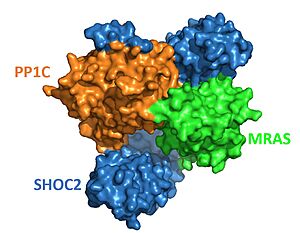Sandbox Reserved 1777
From Proteopedia
(Difference between revisions)
| Line 40: | Line 40: | ||
==Active Site== | ==Active Site== | ||
| - | Once all the domains are bound, [https://en.wikipedia.org/wiki/Nucleoside_triphosphate NTpS] binds to PP1C in the active site. | + | Once all the domains are bound, [https://en.wikipedia.org/wiki/Nucleoside_triphosphate NTpS] binds to PP1C in the active site. NTpS refers to the phosphorylated serine (residue 259) located at the N-terminus of RAF. Once NTpS is bound, PP1C catalyzes the dephosphorylation of serine 259. NTpS is dephosphorylated to prevent the active dimeric RAF from inactivating and changing into its monomeric structure. The <scene name='95/952705/Pp1c_active_site/4'>NTpS active site</scene> is surrounded by hydrophobic and acidic regions along with the C-terminus. These regions are located on the surface of PP1C, whereas the active site is placed further into the structure. It is thought that these regions help the ligand bind to the active site by making interactions that will lead NTpS into the protein. There is still some uncertainty as to how the substrate selectivity works, but these regions could play an essential role in it. Specifically, the pS from NTpS would bind to the hydrophobic region on PP1C<ref name="Liau">PMID:35768504</ref>. |
NTpS can bind to the PP1C active site without PP1C also being bound to SHOC2 and MRAS, however, the catalytic activity is much slower and the reaction is less efficient. In order for NTpS to bind PP1C in the absence of the other two proteins, NTpS would need to be exposed from its binding site in the inactive RAF complex. RAS has to bind to RAF to expose the NTpS allowing PP1C and NTpS to bind. | NTpS can bind to the PP1C active site without PP1C also being bound to SHOC2 and MRAS, however, the catalytic activity is much slower and the reaction is less efficient. In order for NTpS to bind PP1C in the absence of the other two proteins, NTpS would need to be exposed from its binding site in the inactive RAF complex. RAS has to bind to RAF to expose the NTpS allowing PP1C and NTpS to bind. | ||
Revision as of 01:46, 17 April 2023
| This Sandbox is Reserved from February 27 through August 31, 2023 for use in the course CH462 Biochemistry II taught by R. Jeremy Johnson at the Butler University, Indianapolis, USA. This reservation includes Sandbox Reserved 1765 through Sandbox Reserved 1795. |
To get started:
More help: Help:Editing |
| |||||||||||
References
- ↑ 1.0 1.1 Bernal Astrain G, Nikolova M, Smith MJ. Functional diversity in the RAS subfamily of small GTPases. Biochem Soc Trans. 2022 Apr 29;50(2):921-933. doi: 10.1042/BST20211166. DOI:10.1042/BST20211166
- ↑ Molina JR, Adjei AA. The Ras/Raf/MAPK pathway. J Thorac Oncol. 2006 Jan;1(1):7-9. DOI:10.1016/S1556-0864(15)31506-9.
- ↑ Li, L., Zhao, G. D., Shi, Z. et. al.The Ras/Raf/MEK/ERK signaling pathway (Figure 1) and its role in the occurrence and development of HCC. Oncology letters, 12(5), 3045–3050. DOI:10.3892/ol.2016.5110.
- ↑ 4.0 4.1 4.2 Hauseman, Z.J., Fodor, M., Dhembi, A. et al. Structure of the MRAS–SHOC2–PP1C phosphatase complex. Nature 609, 416–423 (2022). doi: 10.1038/s41586-022-05086-1. DOI:10.1038/s41586-022-05086-1.
- ↑ Kwon, J. J., & Hahn, W. C. A Leucine-Rich Repeat Protein Provides a SHOC2 the RAS Circuit: a Structure-Function Perspective. Molecular and cellular biology, 41(4), e00627-20 (2021). doi:10.1128/MCB.00627-20. DOI: 10.1128/MCB.00627-20.
- ↑ Young, L., Rodriguez-Viciana, P. MRAS: A Close but Understudied Member of the RAS Family. Cold Spring Harbor Perspectives in Medicine (2018). doi: 10.1101/cshperspect.a033621. DOI: 0.1101/cshperspect.a033621.
- ↑ Daniel A. Bonsor, Patrick Alexander, Kelly Snead, Nicole Hartig, Matthew Drew, Simon Messing, Lorenzo I. Finci, Dwight V. Nissley, Frank McCormick, Dominic Esposito, Pablo Rodrigiguez-Viciana, Andrew G. Stephen, Dhirendra K. Simanshu. Structure of the SHOC2–MRAS–PP1C complex provides insights into RAF activation and Noonan syndrome. bioRxiv. 2022.05.10.491335. doi: 10.1101/2022.05.10.491335. DOI:10.1101/2022.05.10.491335.
- ↑ 8.0 8.1 8.2 8.3 8.4 Kwon, J.J., Hajian, B., Bian, Y. et al. Structure–function analysis of the SHOC2–MRAS–PP1C holophosphatase complex. Nature 609, 408–415 (2022).doi: 10.1038/s41586-022-04928-2. DOI:10.1038/s41586-022-04928-2
- ↑ 9.0 9.1 9.2 Kwon, J., Jajian, B., Bian, Y. et al. Comprehensive structure-function evaluation of the SHOC2 holophosphatase reveals disease mechanisms and therapeutic opportunities. In: Proceedings of the American Association for Cancer Research Annual Meeting 2022. DOI: 10.1158/1538-7445.AM2022-LB029.
- ↑ Liau NPD, Johnson MC, Izadi S, Gerosa L, Hammel M, Bruning JM, Wendorff TJ, Phung W, Hymowitz SG, Sudhamsu J. Structural basis for SHOC2 modulation of RAS signalling. Nature. 2022 Jun 29. pii: 10.1038/s41586-022-04838-3. doi:, 10.1038/s41586-022-04838-3. PMID:35768504 doi:http://dx.doi.org/10.1038/s41586-022-04838-3
- ↑ 11.0 11.1 Lavoie, H., Therrien, M. Structural keys unlock RAS–MAPK cellular signalling pathway. Nature 609, 248-249 (2022). doi: 10.1038/d41586-022-02189-7. DOI:10.1038/d41586-022-02189-7.
- ↑ 12.0 12.1 van der Burgt, I. Noonan syndrome. Orphanet J Rare Dis 2, 4 (2007). doi: 10.1186/1750-1172-2-4 DOI: 10.1186/1750-1172-2-4.



